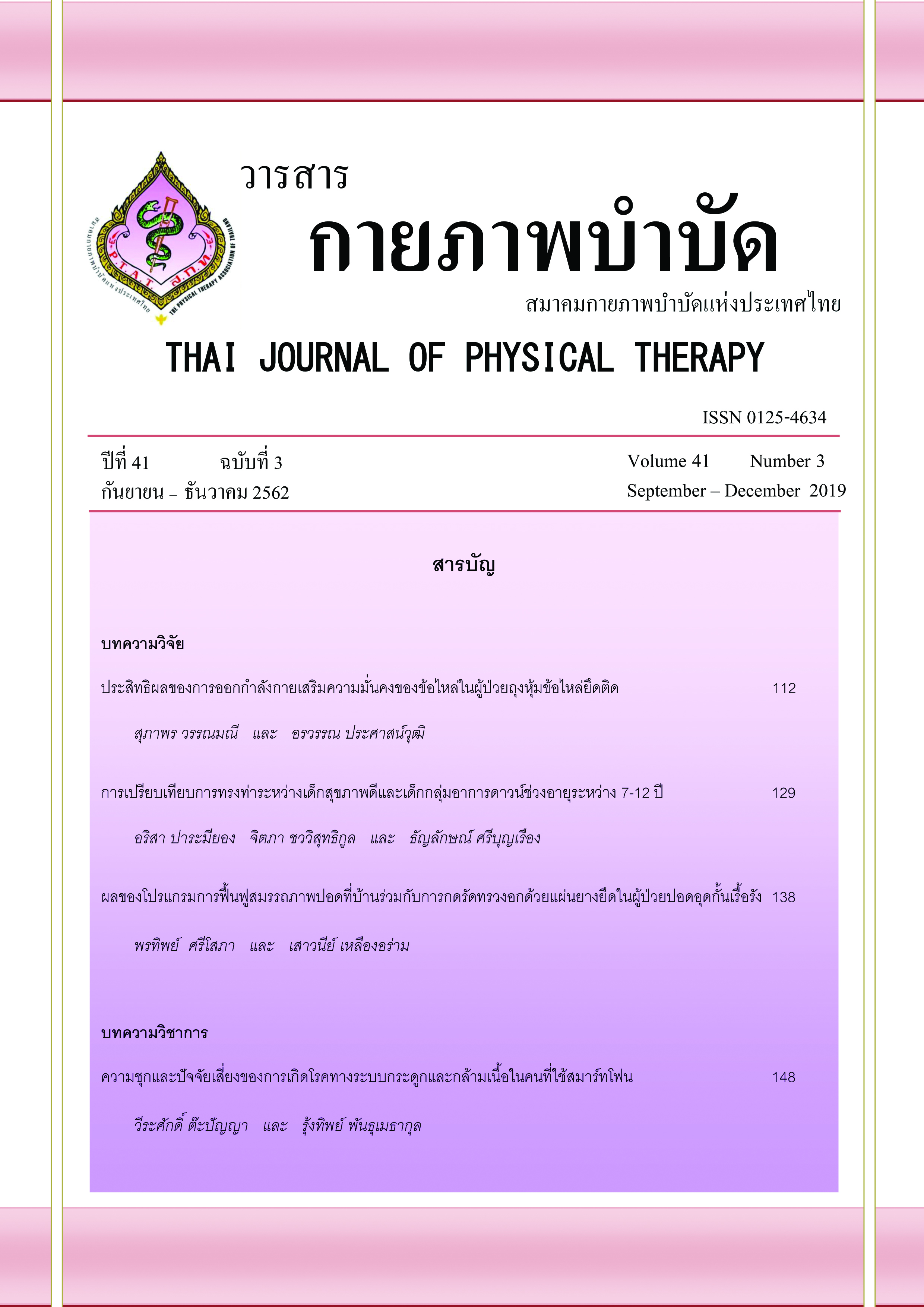ผลของโปรแกรมการฟื้นฟูสมรรถภาพปอดที่บ้านร่วมกับการกดรัดทรวงอกด้วยแผ่นยางยืดในผู้ป่วยปอดอุดกั้นเรื้อรัง
Main Article Content
บทคัดย่อ
ที่มาและความสำคัญ: ภาวะลมคั่งในปอดที่พบในผู้ป่วยปอดอุดกั้นเรื้อรัง ทำให้ทรวงอกสูญเสียความยืดหยุ่น รวมถึงการเคลื่อนไหวและการขยายตัว ความผิดปกตินี้ส่งผลต่อการระบายอากาศ ทำให้หายใจลำบากและความสามารถในการออกกำลังกายลดลง
วัตถุประสงค์: เพื่อศึกษาผลของโปรแกรมการฟื้นฟูสมรรถภาพปอดที่บ้านร่วมกับการกดรัดทรวงอกด้วยแผ่นยางยืดขณะหายใจออกต่อสมรรถภาพปอด ความสามารถในการออกกำลังกาย การขยายตัวของทรวงอก ภาวะหายใจลำบากและคุณภาพชีวิตในผู้ป่วยโรคปอดอุดกั้นเรื้อรัง
วิธีการวิจัย: ผู้ป่วยโรคปอดอุดกั้นเรื้อรังระดับปานกลางถึงรุนแรง เพศชาย ที่มีอาการคงที่ อายุ 40-70 ปี จำนวน 32 คน แบ่งเป็น 2 กลุ่ม คือ กลุ่มควบคุม ได้รับโปรแกรมการฟื้นฟูสมรรถภาพปอดที่บ้าน และกลุ่มทดลอง ได้รับโปรแกรมการฟื้นฟูสมรรถภาพปอดที่บ้านร่วมกับการกดรัดทรวงอกด้วยแผ่นยางยืด 3 ครั้งต่อสัปดาห์ นาน 8 สัปดาห์ ประเมินสมรรถภาพปอด Six-minute walk test (6MWT) การขยายตัวของทรวงอกส่วนบนและส่วนล่าง Modified Medical Research Council (MMRC) dyspnea sore และ COPD Assessment Test (CAT) ก่อนและหลังการเข้าร่วมโปรแกรม
ผลการวิจัย: ค่าสมรรถภาพปอดไม่เปลี่ยนแปลง ในขณะที่ค่า 6MWT, MMRC และ CAT ดีขึ้นอย่างมีนัยสำคัญทางสถิติทั้งในกลุ่มทดลองและกลุ่มควบคุม (p<0.001) หลังการเข้าร่วมโปรแกรม แต่ไม่พบความแตกต่างอย่างมีนัยสำคัญทางสถิติเมื่อเปรียบเทียบระหว่างกลุ่ม (p>0.05) นอกจากนั้น กลุ่มทดลองยังมีการขยายตัวของทรวงอกส่วนบนและส่วนล่างมากกว่าอย่างมีนัยสำคัญทางสถิติ (p<0.001)
สรุปผล: การกดรัดทรวงอกด้วยแผ่นยางยืด ช่วยให้การเคลื่อนไหวของทรวงอกในผู้ป่วยปอดอุดกั้นเรื้อรังเพิ่มขึ้น ถึงแม้จะไม่สามารถทำให้สมรรถภาพปอดดีขึ้นได้ แต่มีแนวโน้มที่จะช่วยลดอาการหอบเหนื่อย และเพิ่มความสามารถในการออกกำลังกายและคุณภาพชีวิตได้
Article Details
References
2. Gea J, Agusti A, Roca J. Pathophysiology of muscle dysfunction in COPD. J Appl Physiol. 2013; 114(9): 1222-34.
3. De Troyer A. Effect of hyperinflation on the diaphragm. Eur Respir J. 1997; 10(3): 708-13.
4. Alter A, Aboussouan LS, Mireles-Cabodevila E. Neuromuscular weakness in chronic obstructive pulmonary disease: chest wall, diaphragm, and peripheral muscle contributions. Curr Opin Pulm Med. 2017; 23(2): 129-38.
5. Parmar D, Bhise A. The immediate effect of chest mobilization technique on chest expansion in patients of COPD with restrictive impairment. Int J Pharm Sci Res. 2015; 4(6): 2413-6.
6. Shakil-ur-Rehman S, Rehman M, Siddique FA, Khan A, Sibtain F. The efficacy of Rib Cage Mobilization on lung function in COPD patients. RMJ. 2013; 38(1): 36-9.
7. Putt MT, Watson M, Seale H, Paratz JD. Muscle stretching technique increases vital capacity and range of motion in patients with chronic obstructive pulmonary disease. Arch Phys Med Rehabil. 2008; 89(6): 1103-7.
8. Yamada M, Sibuya M, Kanamaru A, Tanaka K, Suzuki H, Altose MD, et al. Benefits of respiratory muscle stretch gymnastics in chronic respiratory disease. Showa University Journal of Medical Sciences. 1996; 8(1): 63-71.
9. Heneghan NR, Adab P, Balanos GM, Jordan RE. Manual therapy for chronic obstructive airways disease: a systematic review of current evidence. Man Ther. 2012; 17(6): 507-18.
10. Yoshimi K, Ueki J, Seyama K, Takizawa M, Yamaguchi S, Kitahara E, et al. Pulmonary rehabilitation program including respiratory conditioning for chronic obstructive pulmonary disease (COPD): Improved hyperinflation and expiratory flow during tidal breathing. J Thorac Dis. 2012; 4(3): 259-64.
11. Global strategy for diagnosis, management and prevention of COPD [Internet]. Global Initiative for Chronic Obstructive Lung Disease - GOLD. 2014 [cited 27 September 2015]. Available from: https://www.goldcopd.org/
12. Luangaram S, Srisopa P, Chanavirut R. Home-based exercise in COPD patients. JMTPT. 2018; 30(2) :226-36.
13. Dias FD, Sampaio LM, da Silva GA, Gomes EL, do Nascimento ES, Alves VL, et al. Home-based pulmonary rehabilitation in patients with chronic obstructive pulmonary disease: a randomized clinical trial. Int J Chron Obstruct Pulmon Dis. 2013; 8: 537-44.
14. Hernandez MT, Rubio TM, Ruiz FO, Riera HS, Gil RS, Gomez JC. Results of a home-based training program for patients with COPD. Chest. 2000; 118(1): 106-14.
15. Liu XL, Tan JY, Wang T, Zhang Q, Zhang M, Yao LQ, et al. Effectiveness of home-based pulmonary rehabilitation for patients with chronic obstructive pulmonary disease: a meta-analysis of randomized controlled trials. Rehabil Nurs. 2014; 39(1): 36-59.
16. Troosters T, Casaburi R, Gosselink R, Decramer M. Pulmonary rehabilitation in chronic obstructive pulmonary disease. Am J Respir Crit Care Med. 2005; 172(1): 19-38.
17. MacNee W. Is Chronic Obstructive Pulmonary Disease an Accelerated Aging Disease? Ann Am Thorac Soc. 2016; 13 Suppl 5: S429-S437.
18. Pride NB. Ageing and changes in lung mechanics. Eur Respir J. 2005; 26(4). 563-5.
19. MacNee W. Pathogenesis of chronic obstructive pulmonary disease. Proc Am Thorac Soc. 2005; 2(4): 258-66.
20. De Troyer A, Wilson TA. Effect of acute inflation on the mechanics of the inspiratory muscles. J Appl Physiol Bethesda Md (1985). 2009; 107(1). 315-23.
21. Engel RM, Vemulpad SR, Beath K. Short-term effects of a course of manual therapy and exercise in people with moderate chronic obstructive pulmonary disease: a preliminary clinical trial. J Manipulative Physiol Ther. 2013; 36(8): 490-6.
22. Rasekaba T, Lee AL, Naughton MT, Williams TJ, Holland AE. The six-minute walk test: a useful metric for the cardiopulmonary patient. Intern Med J. 2009;39(8): 495-501.

